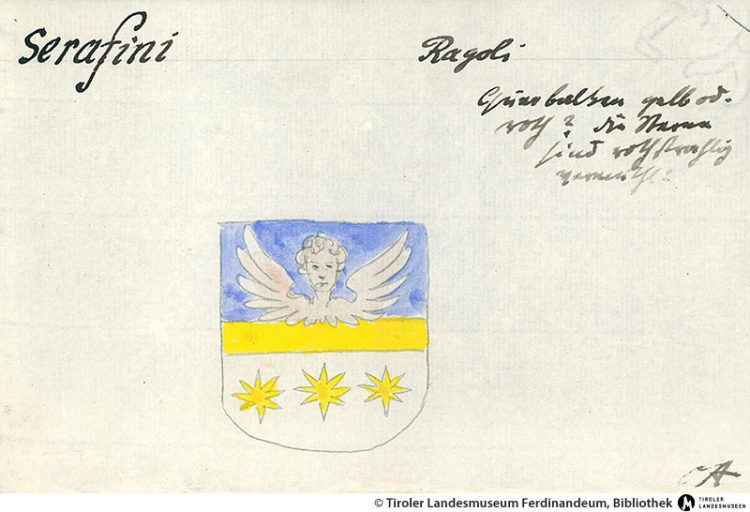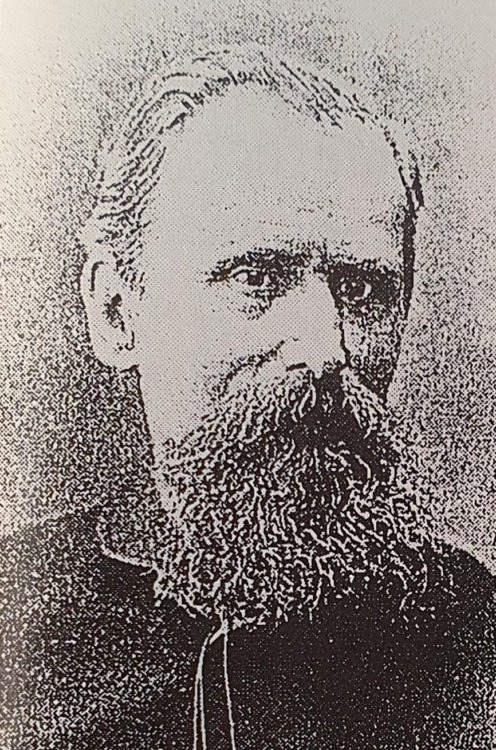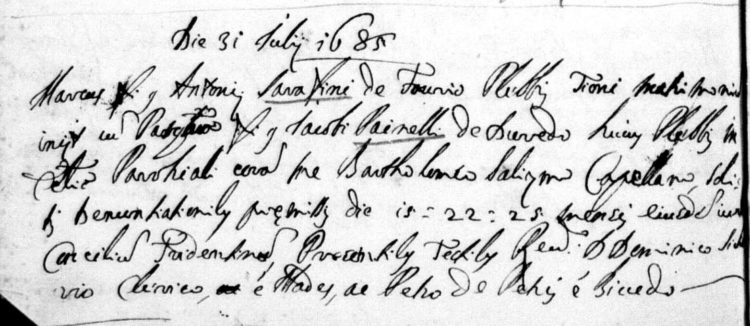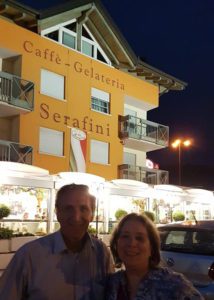Origins and history of the surname Serafini in Preore (Ragoli) and Bleggio in Val Giudicarie, Faver in Val di Cembra, and other parts of Trentino. By genealogist Lynn Serafinn.
Want to keep this article to read offline? You can purchase it as a 10-page printable PDF, complete with clickable table of contents, colour images, charts, footnotes and resource list.
Price: $0.99 (99 cents) USD.
Available in Letter size or A4 size.
Introduction
Spelling Variants: Sarafini; Seraffini; Serrafini; Seraphini; Seraphim; Serafin; Serafino; Serafinn (in USA).
The surname Serafini is derived from the male personal name ‘Serafino’, which in turn comes from the Hebrew/biblical word ‘seraphim’. The biblical seraphim were a type of archangel, sometimes described as ‘resplendent angels’ or ‘angels of fire’.[1] The surname, however, is not a direct reference to seraphim; rather, it means ‘of Serafino’ or ‘belonging to Serafino’, indicating this family is descended from a patriarch whose personal name was Serafino. Hence, ‘Serafini’ is a ‘patronymic’ surname (i.e., ‘from the name of a patriarch’).
As with many patronymics, the surname Serafini is not only widely dispersed throughout the province of Trentino, but it is also found in pretty much every region of the Italian peninsula, especially in central Italy. In fact, its prominence in Trentino is far less than in other parts of Italy: of the estimated 7,094 Serafini families living in Italy today, only 171 (about 2.4%) live in the province of Trento.[2] This is important to remember, as I have met a great many Serafini descendants who freely ‘adopt’ various coat-of-arms of Serafini families from other regions in Italy, who have no ancestral connection to them whatsoever, a practice that can be greatly misleading to future generations.
Moreover, even within Trentino itself, there are several independently arising occurrences of the surname Serafini, and they do not all share the same ancestral history. While I have not yet researched all of these lines back to their source, I hope this article will provide a good starting point for understanding the various Serafini families of the province, and answer some of the questions you might have had about them.
Two Frazioni Called Serafini
Many Serafini descendants become excited when they discover that there are actually two frazioni (hamlets) called ‘Serafini’ in Trentino, both in the south-eastern part of the province: Serafini in Grigno in Valsugana, and Serafini in Tenna, near Levico. The two frazioni are only about 20 miles apart, lying in almost a straight east-west line from each other, not far from the border of northern Veneto. Perhaps this is why historian Anzilotti infers that these place names probably came from the surname Serafini, which she points out is found both in Trentino and in Veneto.[3]
I am not sure if or when the surname ever existed in Grigno, as it does not appear in its Carta di Regola from the 1500s, nor in the 19th century records in the Nati in Trentino database. We do, however, find the Serafini surname in Tenna, albeit in small numbers (as Tenna itself is quite small). Of the 1200+ Serafini children born between 1815-1923, only 57 of them were born in Tenna,[4] and one source reports that there are an estimated 10 people with the surname living there today.[5] I have not personally studied the history of that line, so I do not know how far back they go, or whether they had come there from someplace else in the past. Due to its proximity, it is possible, as Anzilotti seems to suggest, that this particular line had originally migrated into Trentino from Veneto, but I wouldn’t draw that conclusion without further study.
IMPORTANT: When researching your Serafini roots, it is crucial to know that, despite their name, these two hamlets are not the ancestral place of origin of the many other branches of the Serafini in the province.
The Serafini of Favrio in Preore (Present-Day Ragoli)
Beyond doubt, the largest (and possibly the oldest) cluster of Serafini in Trentino originated in Preore Val Giudicarie Interiore. Indeed, the surname appears to have been ‘born’ sometime in the frazione of Favrio in Preore (now considered part of Ragoli) sometime in the 15th century. There, we find a ‘Serafino of Favrio’ appearing in documents in the early 1400s,[6] before the use of surnames had become common practice. By the end of that same century, in a document dated 2 January 1480, we find an ‘Antonio Serafini’ of Favrio listed among the vassals of the feudal community of Preore. [7]
Surely this Antonio was a descendant of the earlier Serafino. We also find that ‘Serafino’ and ‘Antonio’ are commonly recurring personal names in this Serafini family – always living in Favrio[8] – from the earliest surviving parish registers, all the way through the 1600s.[9] For example, the earliest Serafini I have found in Favrio so far was an Antonio Serafini, who married a Cattarina Zurchi on 22 July 1587, whom I estimate was born around 1560.[10]
While the surname still exists in this area today, only about 14% of Serafini births between the years 1815-1923 came from Ragoli, Preore and Tione parishes.[11] Recently, the villages of Ragoli, Preore and Montagne were aggregated into a new municipality called ‘Tre Ville’, where reportedly 10 families with the Serafini surname are currently living.[12] But as we shall see shortly, their descendants continue to flourish in greater numbers in other parts of the Giudicarie.
Unidentified Stemma of Serafini of Ragoli
Amongst the collection of stemmi compiled by Carl Ausserer in 1897, we find this stemma for the ‘Serafini of Ragoli’, which is conserved at the Tiroler Landesmuseum in Innsbruck:[13]

Notice the depiction of an angel in the upper half of the shield, giving a nod back to the meaning of the name (Serafino) from which the surname is derived.
Although this is very pretty, I find this stemma to be a bit of a puzzle. Having checked numerous resources on nobility as well as parish records, I not found even a suggestion that any of the Serafini families in any part of the province were ever ennobled. Moreover, unlike most of the other stemmi in this collection, Ausserer has not provided us with any information about its provenance. Stemmi are not given to surnames; they are awarded to individuals and their heirs. In this image, aside from the words ‘Serafini’ and ‘Ragoli’, the text is just a description of what the stemma looks like. Ausserer gives us no idea of when it was created, or to whom it might have been awarded (or even if it had been awarded). It also doesn’t even resemble any of the stemma from Serafini in other parts of Italy.
Thus, as tempting as it might be, until more information comes to light, I would not recommend ‘claiming’ this stemma as your Serafini family coat-of-arms.
Filippo Serafini of Preore, scholar and author
Although it is a tiny village on a steep slope of a mountain along the Sarca River, Preore is historically associated with having produced a large number of notaries and other legal professionals. But in the case of one particular Serafini of Preore, his study of law took him in a slightly different direction.

Born in Preore on 10 April 1831, Filippo Ottavio Serafini was the youngest of seven children of Domenico Serafini of Preore and Antonia Cominotti of Pinzolo. Two of his brothers had become military men, joining Garibaldi’s campaigns in the 1860s. In contrast, the young Filippo opted to take up an academic life, studying in Innsbruck, Bressanone, Brescia, and Rovereto, and eventually obtaining a degree in Law at the University of Vienna. After working in the Court in Tione, and later obtained a specialist degree after additional studies in Berlin, Sienna, and Heidelberg. Although his family had wanted him to take up a legal profession, he preferred to become a teacher. Throughout the course of his academic career, he authored many scholarly books on the history and principles of law throughout the ages, including his masterwork Elementi di Diritto Romano (Elements of Roman Law), the first version of which he wrote when he was only 26 years old. He died in Pisa at the age of 66, on 15 May 1897.[14]
The Serafini of Bleggio
In the late 1600s, a new branch of Serafini of Favrio started in the parish of Santa Croce del Bleggio. Bleggio is in Giudicarie Esteriore, which lies on the other side of a mountain ridge from Favrio, which is in Giudicarie Interiore.
It began in 1671, when a widower named Antonio Serafini of Favrio (whom I believe may have been the grandson of Antonio Serafini and Cattarina Zurchi mentioned above) married the widow Margherita Malacarne of Sesto the parish of Santa Croce del Bleggio (Giudicarie Esteriore).[15] Margherita’s husband Alberto ‘Bleggi’ Duchi had died a good 10 years earlier, raising her children and running her property on her own, perhaps with the help of some of her older children. After Antonio’s wife Cattarina Floriani died,[16] he married the 48-year-old Margherita, and relocated to his new wife’s parish. Along with him was his teenage son, Marco.
Of course, it is impossible to know the precise reason why Antonio decided to leave his ancestral village, and cross Monte San Martino to go to the other side of the valley. I do know that the Preore/Ragoli and its surrounding villages were particularly hard-hit by a devastating plague that ran rampant in Trentino (and other parts of northern Italy) in 1630. In fact, some of the smaller villages in the area (Irone being the most famous) were completely wiped by the plague. In my research, I have noticed that many of the families of the Preore area shifted about from one place to another in the decades after the plague. Some families moved several times before they finally stabilised. This was surely due to the economic and social imbalances arising in the aftermath of the plague. On the one hand, many artisans, craftsmen, and professionals would have died, making it difficult for communities to sustain life as normal. But on the other hand, many farmlands would have become vacant or bereft of male heirs, providing new economic opportunities for men to acquire these properties. And one way to do so was by marrying a woman (who had no living elder brothers) who had inherited the land from her father or late husband. Although Margherita’s husband died well after the plague, Sesto is rich in farmland. Perhaps a combination of a struggling economy in Ragoli, and an opportunity to secure land in Sesto propelled Antonio to remarry, even though he was already about 60 years old.
Having already given birth to 9 children with her late husband, Margherita was now beyond child-bearing age, so she and Antonio Serafini had no children together. That might have been the end of the Serafini surname in Bleggio, but on 31 July 1685, Antonio’s son Marco married Pasqua Painelli of Duvredo in that parish.[17] In the record, Antonio ‘Sarafini’ [sic], now deceased, is described as being ‘of Favrio in the parish of Tione’.[18]

Marco and Pasqua settled in the frazione of Vergonzo in Bleggio. They had nine children, of which four sons grew up to have families of their own (Antonio, Matteo, Domenico, and Alberto). All of the present-day Serafini of Bleggio are related, as they are all descended from these sons of Marco and Pasqua. This line has been extremely prolific and enduring; about 40% of all Serafini born between 1815-1923 came from Bleggio,[19] and they still comprise the largest faction (about 30%) of Serafini in Trentino today.[20]
Many Serafini families from Bleggio emigrated to the USA in the late 19th and early 20th centuries. Most started out working in the coal mines in western Pennsylvania, and many of their descendants still live in that area today. My own family was among these. My father was born in Duvredo in Bleggio in 1919, and his family emigrated to the US in the 1920s, first to Brandy Camp, Pennsylvania, and later shifted to Brooklyn, New York (where I would later be born). Some time in the 1930s, my grandfather changed our surname from Serafini to ‘Serafinn’.
The Santa Croce parish records contain very few soprannome during the 19th century. However, I know that my particular Serafini line use the soprannome ‘Cenighi’, which was derived from our female ancestor Margherita Giuliani of Ceniga in the parish of Drò, who married Marco and Pasqua’s great-great-grandson Alberto Serafini in 1803.[21] Although I have only ever seen this soprannome in two records, it has nonetheless been passed down verbally through the family since the 19th century. Until I traced our ancestry, however, my cousins in Trentino had no idea of its origin.

IMAGE: Marriage record, dated 22 September 1803 in the parish of Drò, for Alberto, son of Matteo Serafini of Duvredo in the parish of Santa Croce in the Giudicarie, and Margherita Giuliani, daughter of the late Valentino Giuliani of Ceniga. The record says she was 22, but she was actually only 19. As she was a minor and her father was deceased, she had been given permission of the court to marry. Margherita’s father passed away when she was only 11 years old, when he accidentally fell to his death from the top of Monte Anglone. [22]
Other Branches in the Giudicarie
We find several other branches of Serafini cropping up around the Giudicarie, especially in Villa Banale and Tavodo, both near Stenico.[23] The surname was already in Villa Banale by the mid-1500s, as we know of a notary named Girolamo Serafini from that village, who was active in his profession in the year 1570. [24] I have also found births of various Serafini of Villa Banale in the baptismal register for Tavodo in the early 1600s.
Between the years 1815-1923, there were 164 Serafini children born in Tavodo, 91 in Villa Banale, and 7 in Stenico, making this area the second largest group of Serafini in the province (about 22%). We also find smaller numbers in Val Rendena (Pinzolo, Spiazzo Rendena), which is often considered a ‘sub valley’ of the Giudicarie, which is a short distance north of Tione.
While I have not done any detailed research of these Giudicarie lines, owing to their proximity and the fact that many families in these Giudicarie villages share common origins, I would imagine they may ultimately be branches of the Serafini of Preore, or at least connect to them in some way.
Serafini of Faver in Val di Cembra
In the town of Lavis just north of the city of Trento is a large and famous ice cream parlour called ‘Caffè-Gelateria Serafini’. I visited there a few times, and I can personally vouch for the quality of their excellent gelato!

When I first visited their gelateria, I had asked where their Serafini family were from, and they told me they were from Val di Cembra, specifically from the village of Faver. Later, they very kindly allowed my friend Guiscardo Pancheri of Lavis (pictured with me in the photo above) to send me a photo of a family tree they had made of their Serafini ancestors, which they had taken back to the end of the 1600s.
I have not yet had the opportunity to work with the Faver or Cembra parish registers, so I have not yet been able to verify their research. I also don’t know if the Lavis family simply haven’t researched beyond the late 1600s, or if the trail went cold for the Serafini in Faver at that point. Thus, right now I cannot tell you how far back in time the Serafini were in Faver, or whether they had come there from someplace else. I hope to make this a topic of future research on my next trip to Trento.
What I do know, however, is that there were 5 Serafini adult males (i.e., all over the age of 25, and presumably all heads of households) recorded in the 1745 Carta di Regola for Faver.[25] This is a reasonably good indication that the surname had already been present in that community for at least a couple of generations before that date.
Moving forward in time, the Serafini of Cembra and Faver comprised about 7% of the total Serafini births in the province between the years 1815-1923,[26] but apparently fewer than 1% of Trentino Serafini live there today.[27]
A COUPLE OF SIDE NOTES: one thing I find curious is that the place names ‘Favrio’ (in Ragoli) and ‘Faver’ are variants of the same linguistic root, ‘faber’, referring to a blacksmith’s forge. But I am pretty sure this is just a coincidence. Also, I have recently been told by the Lavis branch of the Faver Serafini that a male member of their family is planning to do a Y-DNA test, which should help us determine whether they share any paternal ancestry with my own Giudicarie Serafini. I will update this article when I find out the results.
Closing Thoughts: The Serafini Today
As the trend towards urbanisation has risen, an increasing number of Trentini are leaving their native rural valleys. Thus, we do find the Serafini surname on the rise in the city of Trento, as well as in larger towns like Arco and Riva del Garda.
But by far, the greatest number of Serafini in the province today can be found in the various comuni of the Giudicarie (including Val Rendena), where more than half of the Serafini families of present-day Trentino said to be living.[28] This is surely a testament to the antiquity and endurance of the line in Val Giudicarie for at least the past 600 years. If your Serafini are from the Giudicarie, you might wish to visit the ancient and historic neighbourhood of Favrio in Ragoli, where you will still find many homes bearing dates from the 1500s. You will also see many stunning modern murals on the walls of some of the buildings, which illustrate various chapters in the history of this place, including the devasting plague of 1630. You can find a video I made of my first visit there on my YouTube channel at https://youtu.be/s3kzxuJm95w.
Whenever I meet anyone whose ancestors include the Serafini of Trentino (especially those from the Giudicarie), I can feel an immediate resonance between us. The surname itself has an almost magnetic property. I have personally always loved my primary ancestral surname, and I have always felt a very strong connection with it, even if the spelling and pronunciation of it within my family has changed since emigration. It sounds beautiful when said aloud, and its linguistic root has an ancient, primordial feeling.
But beyond this, and especially for those of us who love genealogy, the surname reminds us we are all descended from an ancient grandfather named Serafino – who lived and died centuries ago, long before the keeping of parish registers. In this way, the surname itself (and indeed any patronymic surname) becomes a connecting link between us and our forefathers, whose DNA ‘made’ us into the people were are today.
Want to keep this article to read offline? You can purchase it as a 10-page printable PDF, complete with clickable table of contents, colour images, charts, footnotes and resource list.
Price: $0.99 (99 cents) USD.
Available in Letter size or A4 size.
If you have any comments or questions, or if you are seeking help researching your Trentino family, please feel free to contact me at https://trentinogenealogy.com/contact.
Until next time!

Warm wishes,
Lynn Serafinn
05 April 2023
P.S. I am currently taking client bookings for JULY 2023 and beyond. If you would like to book a time to discuss having me do research for you, I invite you to read my ‘Genealogy Services’ page, and then drop me a line using the Contact form on this site. Then, we can set up a free 30-minute chat to discuss your project.
Join our Trentino Genealogy Group on Facebook: http://facebook.com/groups/TrentinoGenealogy
Lynn on Twitter: http://twitter.com/LynnSerafinn
View my Santa Croce del Bleggio Family Tree on Ancestry:
https://trentinogenealogy.com/my-tree/
NOTES
[1] BERTOLUZZA, Aldo. 1998. Guida ai Cognomi del Trentino. Trento: Società Iniziative Editoriali (S.R.L.), page 324.
[2] COGNOMIX. https://www.cognomix.it/mappe-dei-cognomi-italiani/SERAFINI/. Accessed 3 April 2023.
[3] ANZILOTTI, Giulia Mastrelli. 2003. Toponomastica Trentina: i nomi delle località abitate. Trento: Provincia autonomia di Trento, Servizio Benni librari e archistici, page 462. Serafini in Grigno only has about 50 people in it today
[4] Based on statistics on the Nati in Trentino website. https://www.natitrentino.mondotrentino.net/.
[5] COGNOMI IN TRENTINO-ALTO ADIGE. https://italia.indettaglio.it/ita/cognomi/cognomi_trentinoaltoadige.html. However, the Cognomix website suggests there are actually 8 Serafini families living in Tenna today.
[6] LEONARDI, Ivo (don). 1989. La Decima di Preore (Ragoli e Montagne). Trento: Grafiche Artigianelli, page 147.
[7] LEONARDI, Ivo (don). 1989. La Decima di Preore (Ragoli e Montagne). Trento: Grafiche Artigianelli, page 155.
[8] There is a narrow, cobbled pedestrian path leading to Favrio, which is called ‘Via Frieri’. The locals told me that ‘Frieri’ was the original dialect name for Favrio.
[9] The early registers for Preore are scattered between those of Tione di Trento and Ragoli, with many gaps.
[10] Tione di Trento parish records, marriages, volume 1, no page number.
[11] Based on statistics gleaned from the Nati in Trentino website. https://www.natitrentino.mondotrentino.net/
[12] COGNOMIX. https://www.cognomix.it/mappe-dei-cognomi-italiani/SERAFINI/TRENTINO-ALTO-ADIGE/TRENTO. Accessed 3 April 2023.
[13] TIROLER LANDESMUSEEN. Tyrolean Coats of Arms. http://wappen.tiroler-landesmuseen.at/index34a.php?wappen_id=27483&drawer=&tr=1#prev
[14] BAITO, Paolo Scalfi. 1987. ‘Filippo Serafini di Preore: professore universitario e senatore del regno’. Judicaria, n. 6 (September-December 1987), page 21-23. Tione: Centro Studi Judicaria.
[15] Antonio and Margherita married 25 January 1672. Santa Croce parish records, marriages, volume 1, no page number.
[16] There are no death records for this time period, but Antonio Serafini’s wife Cattarina Floriani may have died sometime around the birth of their last child (Domenico) on 22 Dec 1669. Ragoli parish records, baptisms, volume 1, page 51.
[17] Santa Croce parish records, marriages, volume 1, no page number.
[18] Ragoli and Preore are curates of the larger parish of Tione di Trento, and that general area is often alternately referred to by any of these place names.
[19] Based on statistics gleaned from the Nati in Trentino website. https://www.natitrentino.mondotrentino.net/
[20] An estimated 55 of the 171 Serafini families in Trentino today live in either Comano Terme (formerly Bleggio Inferiore) or Bleggio Superiore. https://www.cognomix.it/mappe-dei-cognomi-italiani/SERAFINI/TRENTINO-ALTO-ADIGE/TRENTO
[21] Drò parish records, marriages, volume 3, page 65-66.
[22] Valentino died on 17 December 1798. Drò parish records, deaths, volume 4, page 125.
[23] The earlier Villa Banale records are often found in Tavodo, and records for both of these places are sometimes found in Stenico.
[24] STENICO, P. Remo. 1999. Notai Che Operarono Nel Trentino dall’Anno 845. Trento: Biblioteca San Bernardino, page 310.
[25] GIACOMONI, Fabio. 1991. Carte di Regola e Statuti delle Comunità Rurali Trentine. 3 volume set. Milano: Edizioni Universitarie Jaca, volume 3, page 319-320.
[26] Based on statistics gleaned from the Nati in Trentino website. https://www.natitrentino.mondotrentino.net/
[27] An estimated 6 of the 171 Serafini families in Trentino today live in the Cembra area. Two families are said to live in Lavis, surely referring to the family who own the gelateria there. https://www.cognomix.it/mappe-dei-cognomi-italiani/SERAFINI/TRENTINO-ALTO-ADIGE/TRENTO
[28] Using the statistics on the Cognomix website, I added the figures for Comano Terme (the new name for the comune that includes much of Bleggio), Stenico, Pinzolo, Tre Ville, Bleggio Superiore, San Lorenzo (Banale), and Tione, for a total of 90 out of 171.

